北邮国院大三电商在读,随课程进行整理知识点。仅整理PPT和相关法条中相对重要的知识点,个人认为相对不重要的细小的知识点不列在其中。如有错误请指出。转载请注明出处,祝您学习愉快。
编辑软件为Effie,如需要pdf/docx/effiesheet/markdown格式的文件请私信联系或微信联系
Now, let’s start.
Week1
本门课程叫做Intellectual Property Law(以下可能会简称为IP Law),先明确什么是Intellectual Property
Intellectual Property = intangible assets 无形资产
想法,知识等等这种没有实质的东西都是
四种IP Law
Copyright Law 著作权法,版权法
- original creative expression 原创的创意表达【original这个词很重要,在后面我们会详细说】
- e.g. books, movies, art
Patent Law 专利法
- new or improved technologies 新的或改进的技术
- e.g. method for reusable spacecraft(一种可重复使用的航天器制造方法), mRNA vaccine for covid(新型冠状病毒mRNA疫苗)
Trade Secret Law 商业秘密法
- commercial information/ knowhow not known to the public 公众不知道的商业信息/诀窍
- e.g. formula for coca cola, for lao gan ma chilli sauce 可口可乐配方,老干妈辣椒酱配方
Trademark Law 商标法
- Investment and strategies in creating and maintaining a distinct brand identify 在创建和维持一个独特的品牌识别方面的投资和策略
- e.g. Tencent, Apple
为什么要保护IP?(PRC Patent Law Art.1)
Article 1 This Law is enacted for the purpose of protecting the lawful rights and interests of patentees, encouraging invention-creation, promoting the application of inventioncreation, enhancing innovation capability, promoting the advancement of science and technology and the economic and social development
为了保护专利权人的合法权益,鼓励发明创造,促进发明创造的应用,提高创新能力,促进科学技术进步和经济社会发展,制定本法
Copyright Law
版权法的核心是保护“works”,那么这个“works”是怎么定义的呢?
最广泛的定义(PRC Copyright Law Art.3)
Article 3 For purposes of this Law, the term “works” includes, among other things, works of literature, art, natural sciences, social sciences, engineering and technology, which are created in any of the following forms:
(1) written works;
(2) oral works;
(3) musical, dramatic, quyi, choreographic and acrobatic works;
(4) works of the fine arts and architecture;
(5) photographic works;
(6) cinematographic works and works created by a process analogous to cinematography;
(7) graphic works such as drawings of engineering designs and product designs, maps and sketches, and model works;
(8) computer software; and
(9) other works as provided for in laws and administrative regulations.
第三条本法所称作品,包括以下列形式创作的文学、艺术、自然科学、社会科学、工程技术作品:
(1)书面作品;
(2)口头作品;
(3)音乐、戏剧、曲艺、舞蹈、杂技作品;
(4)美术、建筑作品;
(5)摄影作品;
(6)电影作品和类似摄影方法创作的作品;
(7)工程设计、产品设计图纸、地图、草图、模型等图形作品;
(8)计算机软件;和
(9)法律、行政法规规定的其他作品。
对广泛定义的进一步解释(PRC Copyright Law Regulations Art.4)
Article 4 For the purposes of the Copyright Law and these Regulations, the following expressions concerning works shall have the meanings hereunder assigned to them:
(1) “written works” means works expressed in written form, such as novels, poems, essays and theses;
(2) “oral works” means works expressed in form of spoken language, such as impromptu speeches, lectures and court debates;
(3) “musical works” means such works as songs and symphonic works, with or without accompanying words, which can be sung or performed;
(4) “dramatic works” means such works as dramas, operas and local traditional operas for stage performance;
(5) “qu yi works” means such works as “xiang sheng” (cross talk), “kuai shu”(clapper talk), “da gu” (ballad singing with drum accompaniment) and “ping shu”(story telling based on novels), which are mainly performed by recitation or singing, or by both;
(6) “choreographic works” means works in which ideas and feelings are or can be expressed through successive body movements, gestures, facial movements, etc;
(7) “acrobatic works” means works expressed through body movements and skills, such as acrobatics, magic and circus;
(8) “works of fine arts” means two- or three-dimensional works of the plastic arts created in lines, colours or other media which impart aesthetic effect, such as paintings, works of calligraphy and sculptures;
(9) “works of architecture” means works with aesthetic effect which are expressed in form of buildings or structures;
(10) “photographic works” means artistic works created by recording images of objects on light-sensitive or other materials with the aid of devices;
(11) “cinematographic works and works created by a process analogous to cinematography” means works which are recorded on some material, consisting of a series of images, with or without accompanying sound, and which can be projected with the aid of suitable devices or communicated by other means;
(12) “graphic works” means such works as drawings of engineering designs and product designs for the purpose of actual construction and manufacturing, and as maps and sketches showing geographical phenomena and demonstrating the fundamentals or the structure of a thing or an object;
(13) “model works” means three-dimensional works made on the basis of the shape and the structure of an object to a certain scale, for the purpose of display, test or observation.
第四条著作权法和本条例中有关作品的下列用语,具有本条例赋予的含义:
(1)文字作品,是指小说、诗歌、散文、论文等以文字形式表现的作品;
(2)“口头作品”是指即兴演讲、讲座、法庭辩论等以口头形式表现的作品;
(3)“音乐作品”,是指可以演唱或者表演的歌曲、交响乐等配词或者不配词的作品;
(4)戏剧作品,是指戏剧、戏曲、地方戏曲等舞台表演作品;
(5)“曲艺作品”是指以朗诵或演唱为主,或两者兼备的“相声”、“快书”、“打鼓”、“评书”等作品;
(6)舞蹈作品,是指通过连续的肢体动作、手势、表情等表现思想感情的作品;
(7)“杂技作品”,是指杂技、魔术、马戏等以肢体动作和技巧表现的作品;
(8)“美术作品”是指绘画、书法、雕塑等以线条、色彩或者其他材料创作的具有审美效果的二维或者三维造型艺术作品;
(9)“建筑作品”是指以建筑物、构筑物形式表现的具有美学效果的作品;
(10)摄影作品,是指借助装置在感光材料或者其他材料上记录物体图像的艺术作品;
(11)“电影作品和类似摄影的作品”,是指记录在某种材料上的、由一系列有声音或无声音的图像组成的、借助适当装置放映或以其他方式传播的作品;
(12)图形作品,是指以实际施工、制造为目的的工程设计图纸、产品设计图纸,以及展示地理现象、说明事物、物体的基本原理和结构的地图、草图等作品;
(13)“模型作品”,是指根据物体的形状、结构,按一定比例制作的供展示、试验、观察的三维作品。
核心定义条款(PRC Copyright Law Regulations Art.2, 3 + PRC Copyright Law Art.11(部分))
Article 2 The term “works” as referred to in the Copyright Law means intellectual creations with originality in the literary, artistic or scientific domain, insofar as they can be reproduced in a tangible form.
著作权法所称作品,是指在文学、艺术或者科学领域内具有独创性的、能够以有形形式复制的智力创作。
Article 3 The term “creation” as referred to in the Copyright Law means intellectual activities in which literary, artistic or scientific works are directly created.
Any organizational activity, consultation, material support or other auxiliary services conducted or offered for another person’s creation shall not be deemed as creation.
著作权法所称创作,是指直接创作文学、艺术、科学作品的智力活动。
为他人的创作进行或者提供的组织活动、咨询、物质支持或者其他辅助服务,不视为创作。
Art.11 The author of a work is the citizen who creates the work.
作品的作者是创作作品的公民。
核心辨析点1:“originality / original”
- 有originality的work才会被保护,没有的就不会被保护。
- 这个词的定义就是author’s own creation,要完全原创的东西
- PPT给了一个youtube上仿画梵高的画的例子,告诉你无论这个作者花了多少时间金钱心力,都不受法律保护,因为没有originality
核心辨析点2:“idea or expression”
- 最核心的一点就是,idea是可以抄的,expression是不可以抄的
- 还是梵高的例子,你照着人家的画一笔一划的画就是copy了expression,如果梵高画了地上的向日葵,你也画了地上的向日葵,这种就是copy了idea,而不是expression
Moral rights of the Author ‘personality rights’ (Art.10 (1)-(4) )
Article 10
Copyright includes the following personal rights and property rights:
(1) the right of publication, that is, the right to decide whether to make a work available to the public;
(2) the right of authorship, that is, the right to claim authorship in respect of, and to have the author’s name mentioned in connection with, a work;
(3) the right of revision, that is, the right to revise or authorize others to revise a work;
(4) the right of integrity, that is, the right to protect a work against distortion and mutilation;
版权包括以下人身权和财产权:
(1)发表权,即决定作品是否公之于众的权利;
(2)署名权,即表明作者身份和提及作者姓名的权利;
(3)修改权,即修改或者授权他人修改作品的权利;
(4)保护作品完整权,即保护作品不受歪曲、毁损的权利;
对于这四点,PPT给了个表,和上面的几点是一样的,只不过给了一个名称
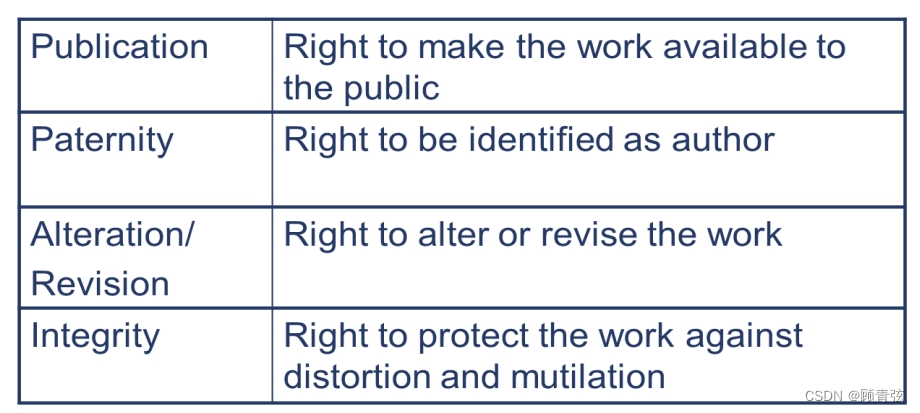
还举了一个HP的例子
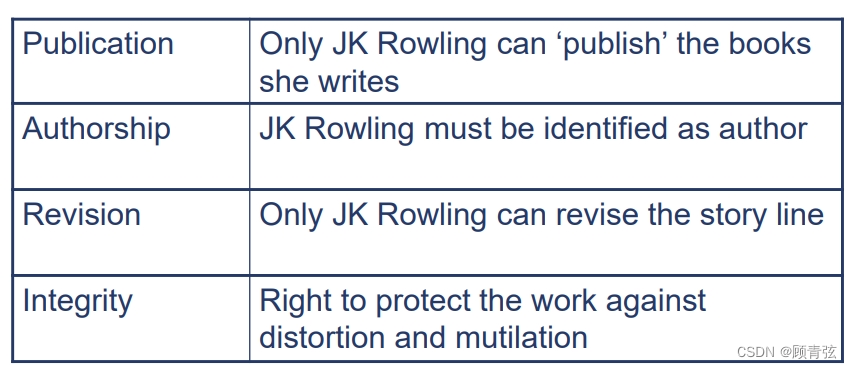
Economic Rights of the Owner ( Art.10 (5)-(17) )
(5) the right of reproduction, that is, the right to produce one or more copies of a work by printing, photocopying, lithographing, making a sound recording or video recording, duplicating a recording, or duplicating a photographic work, or by other means;
(6) the right of distribution, that is, the right to provide the original copy or reproductions of a work to the public by selling or donating;
(7) the right of rental, that is, the right to authorize others to use temporarily a cinematographic work or a work created by a process analogous to cinematography, or computer software, except where the software itself is not the essential object of the rental;
(8) the right of exhibition, that is, the right to publicly display the original copy or reproductions of a work of the fine arts or of a photographic work;
(9) the right of performance, that is, the right to publicly perform a work, and to publicly communicate the performance of a work by any means or process;
(10) the right of presentation, that is, the right to publicly present a work of the fine arts, a photographic work, a cinematographic work, a work created by a process analogous to cinematography, or other works, by projector, slide projector or any other technology or instrument;
(11) the right of broadcasting, that is, the right to broadcast a work or disseminate it to the public by any wireless means, to communicate the broadcast of a work to the public by wire or by rebroadcasting, and to publicly communicate the broadcast of a work by loudspeaker or any other analogous instrument transmitting signs, sounds or images;
(12) the right of communication through information network, that is, the right to make a work available to the public by wire or by wireless means, so that people may have access to the work from a place and at a time individually chosen by them;
(13) the right of cinematography, that is, the right to fix an adaptation of a work in amedium by cinematography or a process analogous to cinematography;
(14) the right of adaptation, that is, the right to change a work into a new one with originality;
(15) the right of translation, that is, the right to change the language in which the work is written into another language;
(16) the right of compilation, that is, the right to compile by selection or arrangement preexisting works or passages therefrom into a new work; and
(17) other rights to be enjoyed by copyright owners.
(5)复制权,即通过印刷、复印、印刷、录音录像、复制录音、复制摄影作品或者其他方法制作作品一幅或者多幅复制品的权利;
(6)发行权,即以出售、捐赠的方式向公众提供作品的原件、复制品的权利;
(7)出租权,即授权他人临时使用电影作品或者以类似电影摄影的方法创作的作品、计算机软件的权利,但软件本身不是租赁的主要目的的除外;
(8)展览权,即公开展示美术作品、摄影作品的原作、复制品的权利;
(9)表演权,即公开表演作品,并以任何方式和过程公开传播表演作品的权利;
(10)展示权,即使用放映机、幻灯机或者其他技术、仪器公开展示美术作品、摄影作品、电影作品、以类似电影摄影的方法创作的作品或者其他作品的权利;
(11)广播权,即广播或者通过无线方式向公众传播作品的权利,通过有线或者转播权向公众传播作品的广播的权利,通过扬声器或者其他发射信号、声音、图像的类似设备公开传播作品的广播的权利;
(12)信息网络传播权,即通过有线或者无线方式向公众提供作品,使人们能够在其自行选择的地点和时间访问其作品的权利;
(13)电影摄影权,即使用电影摄影或者类似电影摄影的方法固定作品在媒介上改编的权利;
(14)改编权,即将作品改为具有独创性的新作品的权利;
(15)翻译权,即将作品所使用的文字改为其他文字的权利;
(16)编辑权,即选择、整理已有的作品或者其中的段落成为新作品的权利;和
(17)著作权人享有的其他权利。
这里同样也有几个表
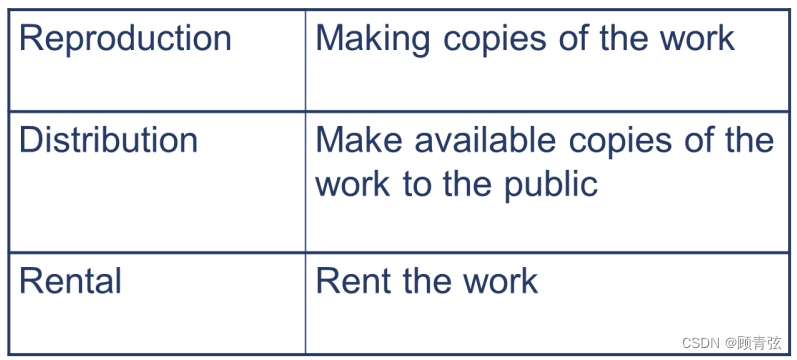
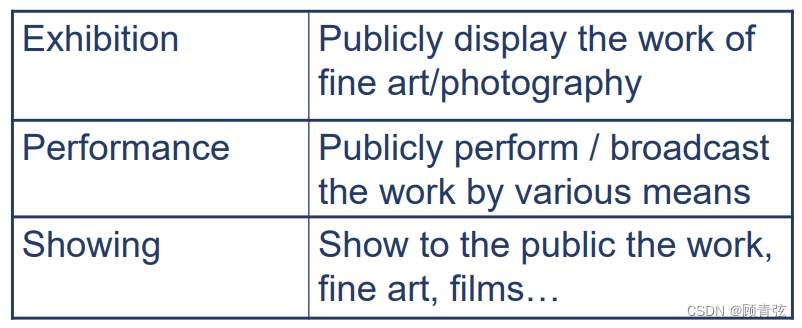

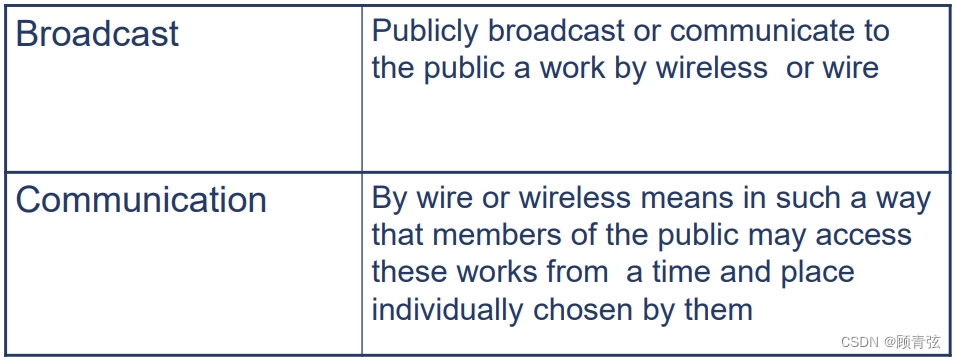
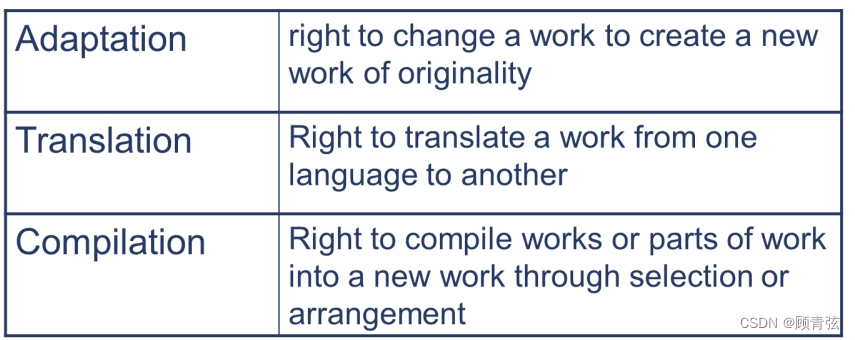
Trademark Law
核心就是一点,判断某个玩意是不是 can be “trademarked” ,能不能成为一个商标
辨析是否为商标的法律(PRC Trademark Law Art.8-14)
重点为9,10,11,12
Article 8
Any signs, including words, graphs, letters, numbers, three-dimensional symbols, color combinations, sound or any combination thereof, that are capable of distinguishing the goods of a natural person, legal person or other organization from those of others may be applied for registration as trademarks.
任何能够将自然人、法人或者其他组织的商品与他人的商品区别开来的标志,包括文字、图形、字母、数字、三维符号、颜色组合、声音或者其组合,都可以申请注册为商标。
Article 9
A trademark submitted for registration shall bear noticeable characteristics and be readily distinguishable, and it may not conflict with the legitimate rights obtained by others earlier.
A trademark registrant shall have the right to indicate the wording “Registered Trademark” or the sign showing that the trademark is registered.
申请注册的商标应当具有显著特征、易于识别,不得与他人在先取得的合法权利相冲突。
商标注册人有权标明“注册商标”字样或者标明该商标已注册的标志。
Article 10
None of the following signs may be used as trademarks:
(1) Those identical with or similar to the State name, the national flag, emblem or anthem, the military flag, emblem or songs, or medals of the People’s Republic of China; or those identical with the names or emblems of Central State organs, the names of the specific locations where the Central State organs are seated; or those identical with the names or designs of landmark buildings;
(2) Those identical with or similar to the State name, national flag, national emblem or military flag etc., of a foreign country, except with the consent of the government of that country;
(3) Those identical with or similar to the name, flag or emblem of an international inter-governmental organization, except with the consent of that organization or except where it is unlikely to mislead the public;
(4) Those identical with or similar to an official mark or inspection stamp that indicates control and guarantee, except where authorized;
(5) Those identical with or similar to the symbol or name of the Red Cross or the Red Crescent;
(6) Those having the nature of discrimination against any nationality;
(7) Those that are deceptive and likely to mislead the public in terms of the quality, place of production or other characteristics of the goods; and
(8)Those detrimental to socialist ethics or customs, or having other unwholesome influences.
No geographical names of administrative divisions at or above the county level or foreign geographical names known to the public may be used as trademarks, except where geographical names have other meanings or constitute part of a collective trademark or certification trademark. Registered trademarks in which geographical names are sued shall remain valid.
下列标志不得作为商标使用:
(1)同中华人民共和国国名、国旗、国徽、国歌、军旗、国徽、国歌、勋章相同或者近似的;与中央国家机关名称、标志、中央国家机关具体所在地名称相同的;或与地标性建筑物名称或设计相同的;
(2)与外国的国家名称、国旗、国徽、军旗等相同或者近似的,但经该国政府同意的除外;
(3)同政府间国际组织的名称、旗帜、徽标相同或者近似的,但经该组织同意或者不易误导公众的除外;
(4)与标明管理、保证的官方标志、检验印章相同或者近似的,但经授权的除外;
(5)同红十字、红新月标志、名称相同或者近似的;
(6)具有民族歧视性质的;
(7)在商品的质量、产地或者其他特性方面具有欺骗性,容易误导公众的;而且
(8)有损于社会主义道德风尚或者其他不良影响的。
县级以上行政区划的地名和公众已知的外国地名,不得作为商标使用,但地名另有含义或者构成集体商标、证明商标的除外。以地名提起诉讼的注册商标继续有效。
Article 11
None of the following marks may be registered as trademarks:
(1) Where the mark bears only the generic name, design, or model number of the goods concerned;
(2) Where it only directly indicates the quality, principal raw materials, function, use, weight, quantity or other features of the goods; and
(3) Signs that otherwise lack any distinctive character.
Any mark mentioned in the preceding paragraph may be registered as a trademark if it has acquired distinctive features through use and is readily distinguishable.
下列标志不得注册为商标:
(1)商标仅记载商品的通用名称、外观设计或者型号的;
(2)仅直接标明货物的质量、主要原料、功能、用途、重量、数量或者其他特征的;而且
(3)缺乏任何显著特征的标识。
前款所列标志经使用具有显著特征,易于识别的,可以注册为商标。
Article 12
No application for registration of a three-dimensional symbol as a trademark may be granted, where the sign merely indicates the shape inherent in the nature of the goods concerned, or it is only dictated by the need to achieve technical effects or the need to give the goods substantive value.
三维标志作为商标的注册申请,如果该标志仅仅表示有关商品的性质所固有的形状,或者仅仅是为了达到技术效果或者需要赋予该商品实质性价值,则不予核准。
Article 13 A holder of a trademark that is well known by the relevant public may, if he holds that his rights have been infringed upon, request for well-known trademark protection in accordance with this Law.
Where the trademark of an identical or similar kind of goods is a reproduction, imitation, or translation of another person’s well-known trademark not registered in China and is liable to cause public confusion, no application for its registration may be granted and its use shall be prohibited.
Where the trademark of a different or dissimilar kind of goods is a reproduction, imitation, or translation of another person’s well-known trademark not registered in China and it misleads the public so that the interests of the owner of the registered well-known trademark are likely to be impaired, no application for its registration may be granted and its use shall be prohibited.
第十三条有关公众熟知的商标权利人认为其权利受到侵害的,可以依照本法要求驰名商标保护。
同一种或者类似商品的商标是复制、模仿或者翻译他人未在中国注册的驰名商标,容易引起公众混淆的,不得批准注册并禁止使用。
不同或者不同类商品的商标复制、模仿或者翻译他人未在中国注册的驰名商标,误导公众,容易损害已注册驰名商标所有人的利益的,不得申请注册并禁止使用。
Article 14 A well-known trademark shall be recognized as a fact that needs to be ascertained in dealing with a trademark-related case upon request by the party concerned. The following factors shall be taken into consideration in the recognition of a well-known trademark:
(1) The recognition degree of the trademark among the relevant public;
(2) The duration in which the trademark has been in use;
(3) The duration, extent and geographical scope of all publicity operations carried out for the trademark;
(4) The records of protection of a well-known trademark provided for the trademark and
(5) Other factors making the trademark well-known.
Where the party concerned claims rights according to Article 13 of this Law in a trademark registration review or during the process whereby the administrative department for industry and commerce investigates and deals with a case involving trademark infringement, the trademark office concerned may, based on the need for reviewing or dealing with the case, decide whether or not to recognize the relevant trademark as a well-known one.
Where the party concerned claims rights according to Article 13 of this Law, during the handling of a trademark dispute, the trademark review and adjudication board may, based on the need for handling the cases, decide whether or not to recognize the relevant trademark as a well-known one.
Where the party concerned claims rights according to Article 13 of this Law during the hearing of a civil or administrative case involving a trademark, the people’s court designated by the Supreme People’s Court may, based on the need for trying the case, decide whether or not to recognize the relevant trademark as a well-known one.
No manufacturers and business operators may indicate the words “well-known trademark" upon the goods, the packaging or the containers of the goods, nor may they use the same for advertising, exhibition or other commercial activities.
第十四条驰名商标在处理有关商标案件时,当事人提出请求,应当认定为需要查明的事实。驰名商标认定应当考虑下列因素:
(一)商标在相关公众中的认可度;
(二)商标使用期限;
(三)商标宣传活动的持续时间、范围和地域范围;
(四)为该商标提供的驰名商标保护记录
(五)使商标驰名的其他因素。
当事人在商标注册审查或者工商行政管理部门查处商标侵权案件过程中依照本法第十三条规定主张权利的,商标局根据审查或者处理的需要,可以认定该商标是否驰名。
当事人在处理商标纠纷中依照本法第十三条的规定主张权利的,商标评审委员会可以根据处理案件的需要,决定是否认定有关商标为驰名商标。
当事人在审理商标民事案件或者行政案件中依照本法第十三条规定主张权利的,最高人民法院指定的人民法院根据审理案件的需要,可以决定是否认定该商标为驰名商标。
生产者、经营者不得在商品、商品包装或者商品容器上标明“驰名商标”字样,也不得用于广告宣传、展览或者其他商业活动。
核心条款的分析(不想看上面的条款的省流版)
这里PPT有个图,我们直接上图
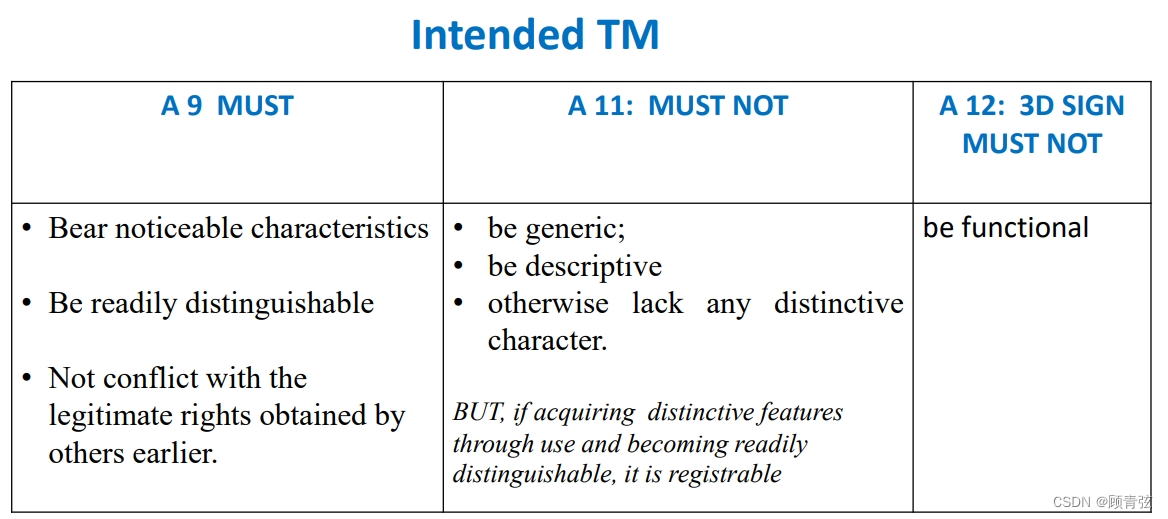
我们翻译一下
就是说,trademark必须要
- 具有明显的特点
- 易于区分
- 不与他人在先取得的合法权利相冲突。
必须不能
- 是通用的
- 是描述性的
- 缺乏特色的
但是,如果通过使用而获得独特的特征并变得易于区分,则可以注册
如果你的TM是3D的,那么必须不能
- 仅仅表述其功能(不太好翻译,具体看Art.12)
商标必须具有的核心特点:distinctive 独特的
我们上面的所有法律都是为了保证TM是distinctive的,换句话说,上面的所有法律都可以作为distinctive的定义来看
US关于distinctive的界定(DETERMINATION OF REGISTRABILITY RELIES 可注册性的界定)
也可以叫做distinctiveness scale 显著性量表
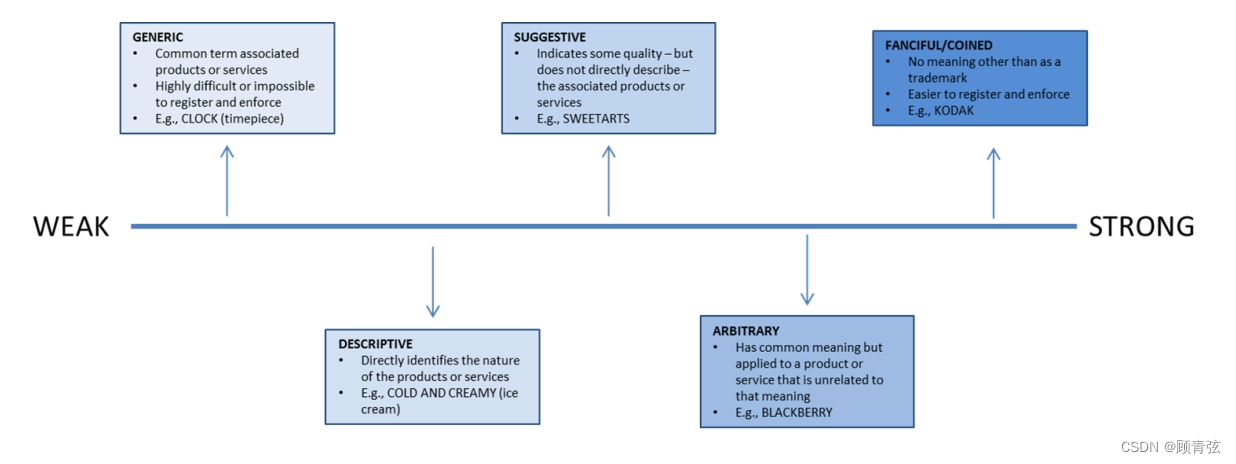
越往右说明越distinctive,越好regist
从左到右依次是:
- Generic 通用的
- common term associated products or services
- 通用术语相关产品或服务
- highly difficult or impossible to register and enforce
- 很难或不可能登记和执行的
- e.g. CLOCK(timepiece)
- Descriptive 描写的
- directly identifies the nature of the products or services
- 直接识别产品或服务的性质
- e.g. COLD AND CREAMY(ice cream)
- Suggestive 暗示的
- indicates some quality - but does not directly describe - the associated products or services
- 表示某些质量-但不直接描述-相关的产品或服务
- e.g. SWEETARTS
- Arbitrary 任意的
- has common meaning but applied to a product or service that is unrelated to that meaning
- 具有常见的含义,但用于与该含义无关的产品或服务
- e.g. BLACKBERRY
- Fanciful / Coined 幻想的/创造的
- no meaning other than as a trademark
- 除了作为商标,没有别的意思
- easier to register and enforce
- 更容易注册和执行
- e.g. KODAK
对这五个attributes举个例子
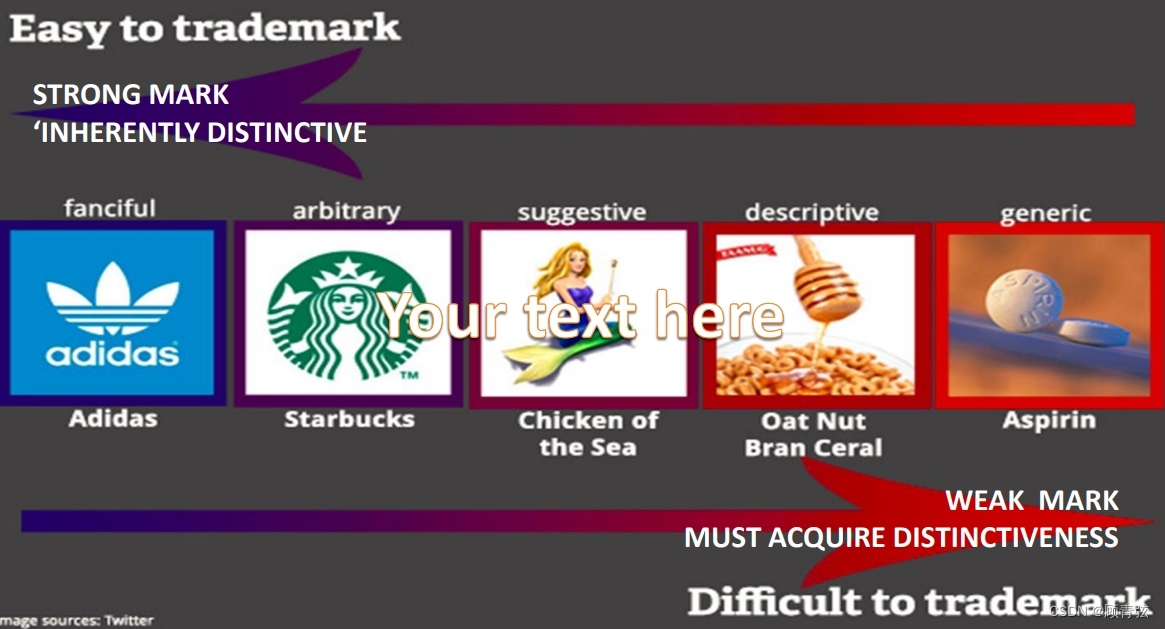
China TM Office 对于 distinctive的定义(和前面差不多,看看得了).
the trademark mark itself should
- ensure easy identification, so that 确保易于识别,以便
- consumers can make an impression on it, and 消费者可以给它留下印象,而且
- keep this impression in their memory, so as to 把这个印象留在他们的记忆中,以便
- finally play the role of distinguishing the source of goods or services. 最后起到区分商品或服务来源的作用。
Patent Law
核心:5 conditions for patentability
- Subject matter
- Practical applicability
- Novelty
- Non-obviousness
- Disclosure
Subject matter(PRC Patent Law Art.2, 5, 25)
Article 2
For the purposes of this Law, invention-creations mean inventions, utility models and designs.
Inventions mean new technical solutions proposed for a product, a process or the improvement thereof.
Utility models mean new technical solutions proposed for the shape and structure of a product, or the combination thereof, which are fit for practical use.
Designs mean, with respect to a product, new designs of the shape, pattern, or the combination thereof, or the combination of the color with shape and pattern, which are rich in an aesthetic appeal and are fit for industrial application.
本法所称发明创造,是指发明、实用新型和外观设计。
发明是指对产品、工艺或其改进提出的新的技术解决方案。
实用新型是指对产品的形状、结构提出的新的、适合实际使用的技术方案或者两者的结合。
设计,是指产品的形状、图案及其组合的新设计,或者颜色与形状、图案的结合,具有丰富的审美情趣,适合工业应用。
Article 5
Patent rights shall not be granted for invention-creations that violate the law or social ethics, or harm public interests.
Patent rights shall not be granted for inventions that are accomplished by relying on genetic resources which are obtained or used in violation of the provisions of laws and administrative regulations.
对违反法律、社会公德、损害社会公共利益的发明创造,不得授予专利权。
对违反法律、行政法规规定取得或者使用的遗传资源,依靠遗传资源完成的发明,不授予专利权。
Article 25
Patent rights shall not be granted for any of the following:
(1) scientific discoveries;
(2) rules and methods for intellectual activities;
(3) methods for the diagnosis or treatment of diseases;
(4) animal or plant varieties;
(5) substances obtained by means of nuclear transformation; and
(6) designs that are mainly used for marking the pattern, color or the combination of the two of prints.
对下列任何一种,不得授予专利权:
(1)科学发现;
(2)智力活动规则和方法;
(3)疾病的诊断、治疗方法;
(4)动植物品种;
(5)通过核转化获得的物质;而且
(6)主要用于标记图案、颜色或两者相结合的图案。
Practical applicability(Art.22)
Art.22(部分)
Practical use means that the said invention or utility model can be used for production or be utilized, and may produce positive results.
实用,是指该发明或者实用新型能够用于生产或者被利用,并可能产生积极效果。
Novelty(Art.22)
Art.22(部分)
Novelty means that the invention or utility model concerned is not an existing technology; no patent application is filed by any unit or individual for any identical invention or utility model with the patent administration department under the State Council before the date of application for patent right, and no identical invention or utility model is recorded in the patent application documents or the patent documentations which are published or announced after the date of application.
新颖性,是指该发明或者实用新型不是现有技术;任何单位或者个人在专利权申请日以前没有就相同的发明或者实用新型向国务院专利行政部门提出专利申请,并且在专利申请文件和申请日后公布的专利文件中没有记载相同的发明或者实用新型。
Non-obviousness(也叫creativity)(Art.22)
Art.22(部分)
Creativity means that, compared with the existing technologies, the invention possesses prominent substantive features and indicates remarkable advancements, and the utility model possesses substantive features and indicates advancements.
创造性,是指该发明与现有技术相比,具有突出的实质性特征和显著的先进性,该实用新型具有实质性特征和先进性。
Disclosure(PRC Patent Law Art.26 , PRC Patent Law Regulations Art.17)
意思就是啥啥都得写明白了公开了
Article 26
When a person intends to apply for an invention or utility model patent, he shall submit the relevant documents, such as a written request, a written description and its abstract, and a written claim.
In the written request shall be specified the name of the invention or utility model, the name of the inventor or designer, the name or title and the address of the applicant and other related matters.
The written description shall contain a clear and comprehensive description of the invention or utility model so that a technician in the field of the relevant technology can carry it out; when necessary, pictures shall be attached to it. The abstract shall contain a brief introduction to the main technical points of the invention or utility model.
The written claim shall, based on the written description, contain a clear and concise definition of the proposed scope of patent protection.
With regard to an invention-creation accomplished by relying on genetic resources, the applicant shall, in the patent application documents, indicate the direct and original source of the genetic resources. If the applicant cannot indicate the original source, he shall state the reasons.
申请发明或者实用新型专利,应当提交请求书、说明书及其摘要、权利要求书等有关文件。
请求书应当写明发明或者实用新型的名称、发明人或者设计人的姓名、申请人的姓名或者职称、地址以及其他有关事项。
说明书应当对发明或者实用新型作出清晰、全面的说明,以便相关技术领域的技术人员能够实施;必要时,应附有图片。摘要应当对发明或者实用新型的主要技术要点作简要介绍。
权利要求书应当在说明书的基础上,明确、简明地说明专利保护的范围。
依靠遗传资源完成的发明创造,申请人应当在专利申请文件中说明遗传资源的直接来源和原始来源。申请人不能说明原来源的,应当说明理由。
Rule 17 (Incorporating original Rule 18)
The description of an application for a patent for invention or utility model shall state the title of the invention or utility model, which shall be the same as it appears in the request. The description shall include the following:
(1) Technical field: specifying the technical field to which the technical solution for which protection is sought pertains;
(2) Background art: indicating the background art which can be regarded as useful for the understanding, searching and examination of the invention or utility model, and when possible, citing the documents reflecting such art;
(3) Contents of the invention: disclosing the technical problem the invention or utility model aims to settle and the technical solution adopted to resolve the problem; and stating, with reference to the prior art, the advantageous effects of the invention or utility model;
(4) Description of figures: briefly describing each figure in the drawings, if any;
(5) Mode of carrying out the invention or utility model: describing in detail the optimally selected mode contemplated by the applicant for carrying out the invention or utility model; where appropriate, this shall be done in terms of examples, and with reference to the drawings, if any.
The manner and order referred to in the preceding paragraph shall be followed by the applicant for a patent for invention or for utility model, and each of the parts shall be preceded by a heading, unless, because of the nature of the invention or utility model, a different manner or order would result in a better understanding and a more economical presentation.
The description of the invention or utility model shall use standard terms and be in clear wording, and shall not contain such references to the claims as: “as described in claim…¬”, nor shall it contain commercial advertising.
Where an application for a patent for invention contains disclosure of one or more nucleotide and/or amino acid sequences, the description shall contain a sequence listing in compliance with the standard prescribed by the Patent Administration Department under the State Council. The sequence listing shall be submitted as a separate part of the description, and a copy of the said sequence listing in machine-readable form shall also be submitted in accordance with the provisions of the Patent Administration Department under the State Council.
The description of the utility model for which a patent is applied for shall contain drawings indicating the shape, structure or their combanition of the product for which protection is sought.
发明或者实用新型专利申请的说明书应当写明发明或者实用新型的名称,应当与请求书中的名称一致。描述应包括以下内容:
(1)技术领域:载明请求保护的技术方案所属于的技术领域;
(2)背景图:表明对理解、检索和审查发明或者实用新型可能有用的背景图,并在可能的情况下引用反映该背景图的文献;
(3)发明的内容:公开本发明或者实用新型所要解决的技术问题和解决该问题所采用的技术方案;参照现有技术说明发明或者实用新型的有利效果;
(4)图形描述:如有图形,应简要描述图纸中的每个图形;
(5)实施发明或者实用新型的方式:详细说明申请人所设想的实施发明或者实用新型的最佳选择的方式;在适当的情况下,这应根据示例和参考图纸(如果有的话)来完成。
发明专利或者实用新型专利的申请人应当按照前款规定的方式和顺序申请专利,并在每部分前加标题,但由于发明或者实用新型的性质,如果采用不同的方式或者顺序申请专利,将导致前款规定的方式和顺序的除外
发明或者实用新型说明书应当使用规范的术语,文字清晰,不得提及权利要求“如权利要求所述”,也不得含有商业广告。
发明专利申请中公开一个或者多个核苷酸和(或者)氨基酸序列的,说明书中应当包括符合国务院专利行政部门规定的标准的序列清单。顺序清单应当作为说明书的单独部分提交,并按照国务院专利行政部门的规定提交该顺序清单的机器可读副本。
申请专利的实用新型说明书应当附有说明请求保护产品的形状、结构或者其组合的图形。
接下来是关于copyrights,trademarks和patents的对比
acquiring the rights 申请权利的难易程度
- Copyrights: Registration optional, no examination 自选是否注册,不测试
- Trademarks: Registration required, Examination of mark by CTMO, Grant of TM may be challenged 要求注册,由CTMO审查商标,TM的授予可能会被质疑
- Patents: Registration Required, Examination of application by PTO, Grant of patent may be challenged 要求注册,PTO审查申请,专利授予可能会受到质疑
Strength & Duration of the Rights 权利的强度和期限
- Copyrights
- Weak protection
- Ideas not protected
- Independent copying allowed
- Duration: Lifetime of author +50 years
- Trademarks
- Strong protection
- Mark as registered – for goods/services for which registered
- Duration: Perpetual as long as TM kept in use and renewal fee paid 永久,只要TM继续使用,并支付续期费用
- Patents
- Strong protection
- Independently arriving at technical solution – no rights given 独立提出技术解决方案-不授予任何权利
- Duration: 20 years
所有的IP Laws都有rights和limitations
这里PPT给了两个rights和limitation对照的例子,两条对照着看就行
- Rights
- right to earn from intellectual effort 从智力努力中赚钱的权利
- Non-owners have to buy the work or acquire the permission to use the work against payment to owner (assignment and licence) 非所有者必须购买作品或获得使用作品的许可,并向所有者付款 (转让和许可证)
- Limitation
- right to some benefits from another person’s intellectual effort – as long as does not unreasonably affect the owner’s right to earn from their effort 从他人的智力努力中获得一些利益的权利——只要不不合理地影响所有者从他们的努力中获得收益的权利
- Non-owners are given the right to use the work without needing permission against payment to owner 非所有者被赋予使用作品的权利,而不需要向所有者支付许可
关于三种IP的各自的rights和limitation
这里首先PPT给了张图,直接找法律就行
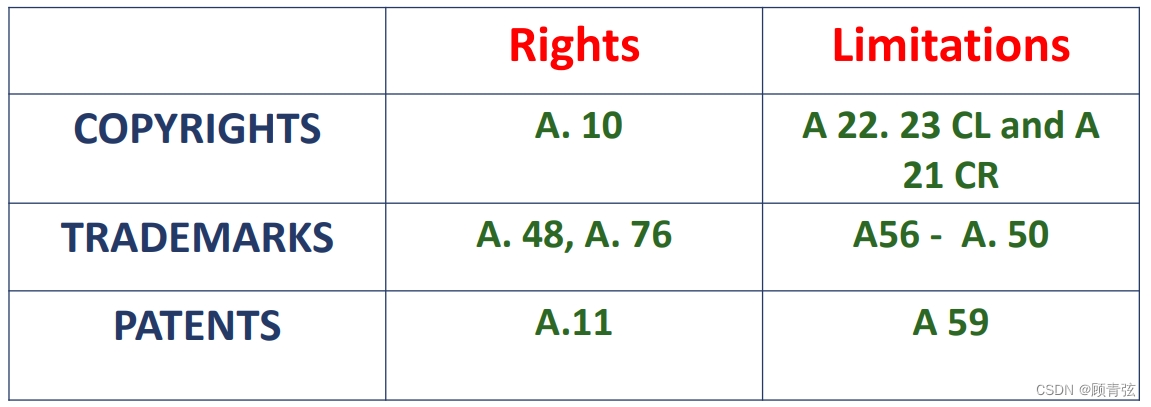
为了方便大家的复习和阅读,这里我直接把所有相关法律贴出
以下CL指PRC Copyright Law,CR指PRC Copyright Law Regulation,这里我们尊重PPT的写法,以后也可能会用这种写法,请注意辨析
Copyrights
Rights(Art.10 CL)
Article 10 (部分)
Copyright includes the following personal rights and property rights:
(1) the right of publication, that is, the right to decide whether to make a work available to the public;
(2) the right of authorship, that is, the right to claim authorship in respect of, and to have the author’s name mentioned in connection with, a work;
(3) the right of revision, that is, the right to revise or authorize others to revise a work;
(4) the right of integrity, that is, the right to protect a work against distortion and mutilation;
(5) the right of reproduction, that is, the right to produce one or more copies of a work by printing, photocopying, lithographing, making a sound recording or video recording, duplicating a recording, or duplicating a photographic work, or by other means;
(6) the right of distribution, that is, the right to provide the original copy or reproductions of a work to the public by selling or donating;
(7) the right of rental, that is, the right to authorize others to use temporarily a cinematographic work or a work created by a process analogous to cinematography, or computer software, except where the software itself is not the essential object of the rental;
(8) the right of exhibition, that is, the right to publicly display the original copy or reproductions of a work of the fine arts or of a photographic work;
(9) the right of performance, that is, the right to publicly perform a work, and to publicly communicate the performance of a work by any means or process;
(10) the right of presentation, that is, the right to publicly present a work of the fine arts, a photographic work, a cinematographic work, a work created by a process analogous to cinematography, or other works, by projector, slide projector or any other technology or instrument;
(11) the right of broadcasting, that is, the right to broadcast a work or disseminate it to the public by any wireless means, to communicate the broadcast of a work to the public by wire or by rebroadcasting, and to publicly communicate the broadcast of a work by loudspeaker or any other analogous instrument transmitting signs, sounds or images;
(12) the right of communication through information network, that is, the right to make a work available to the public by wire or by wireless means, so that people may have access to the work from a place and at a time individually chosen by them;
(13) the right of cinematography, that is, the right to fix an adaptation of a work in a medium by cinematography or a process analogous to cinematography;
(14) the right of adaptation, that is, the right to change a work into a new one with originality;
(15) the right of translation, that is, the right to change the language in which the work is written into another language;
(16) the right of compilation, that is, the right to compile by selection or arrangement preexisting works or passages therefrom into a new work; and
(17) other rights to be enjoyed by copyright owners.
版权包括以下人身权和财产权:
(1)发表权,即决定作品是否公之于众的权利;
(2)署名权,即表明作者身份和提及作者姓名的权利;
(3)修改权,即修改或者授权他人修改作品的权利;
(4)保护作品完整权,即保护作品不受歪曲、毁损的权利;
(5)复制权,即以印刷、影印、平版印刷、录音录像、复制录音制品、复制摄影作品或者其他方法复制一份或者多份作品的权利;
(6)发行权,即以出售或者捐赠的方式向社会提供作品的原件或者复制品的权利;
(7)出租权,即授权他人临时使用电影作品或者类似于电影创作的作品、计算机软件的权利,但软件本身不是出租的主要客体的除外;
(8)展览权,即公开展示美术作品、摄影作品的原件或者复制品的权利;
(9)表演权,即公开表演作品的权利,以及以任何方式和过程公开传播作品表演的权利;
(10)展映权,即利用放映机、幻灯机或者其他技术、仪器公开展示美术作品、摄影作品、电影作品、类似摄影的作品或者其他作品的权利;
(11)播音权,即以无线方式播音或者向公众传播作品,以有线或者重播方式向公众传播作品的播音,以扩音器或者其他类似工具向公众传播作品的播音的权利
(12)信息网络传播权,即将作品以有线或者无线方式提供给公众,使人们可以在自己选择的时间和地点观看该作品的权利;
(13)摄制权,即通过摄制术或者类似摄制术的方法将作品改编成某种媒介的权利;
(14)改编权,即将作品改编成具有独创性的新作品的权利;
(15)翻译权,即将作品的文字改为另一种文字的权利;
(16)编辑权,即将已有的作品或者其中的段落选择、整理成新作品的权利;而且
(17)著作权人享有的其他权利。
Limitations(Art.22,23 CL, Art.21 CR)
Article 22 CL
In the following cases, a work may be used without permission from, and without payment of remuneration to, the copyright owner, provided that the name of the author and the title of the work are mentioned and the other rights enjoyed by the copyright owner in accordance with this Law are not prejudiced:
(1) use of another person’s published work for purposes of the user’s own personal study, research or appreciation;
(2) appropriate quotation from another person’s published work in one’s own work for the purpose of introducing or commenting a certain work, or explaining a certain point;
(3) unavoidable inclusion or quotation of a published work in the media, such as in a newspaper, periodical and radio and television program, for the purpose of reporting current events;
(4) publishing or rebroadcasting by the media, such as a newspaper, periodical, radio station and television station, of an article published by another newspaper or periodical, or broadcast by another radio station or television station, etc. on current political, economic or religious topics, except where the author declares that such publishing or rebroadcasting is not permitted;
(5) publishing or broadcasting by the media, such as a newspaper, periodical, radio station and television station of a speech delivered at a public gathering, except where the author declares that such publishing or broadcasting is not permitted;
(6) translation, or reproduction in a small quantity of copies of a published work by teachers or scientific researchers for use in classroom teaching or scientific research, provided that the translation or the reproductions are not published for distribution;
(7) use of a published work by a State organ to a justifiable extent for the purpose of fulfilling its official duties;
(8) reproduction of a work in its collections by a library, archive, memorial hall, museum, art gallery, etc. for the purpose of display, or preservation of a copy, of the work;
(9) gratuitous live performance of a published work, for which no fees are charged to the public, nor payments are made to the performers;
(10) copying, drawing, photographing or video-recording of a work of art put up or displayed in an outdoor public place;
(11) translation of a published work of a Chinese citizen, legal entity or other organization from Han language into minority nationality languages for publication and distribution in the country; and
(12) transliteration of a published work into braille for publication.
在下列情况下使用作品,可以不经著作权人许可,不向其支付报酬,但不得提及作者姓名、作品名称以及著作权人依照本法享有的其他权利:
(1)为个人学习、研究或者欣赏的目的,使用他人已经发表的作品;
(2)在自己的作品中,为介绍、评论某一作品或者说明某一观点,适当引用他人已经发表的作品;
(3)报纸、期刊、广播、电视等传播媒介为报道时事,不可避免地引用或者引用已经发表的作品;
(4)报纸、期刊、广播之声、电视台等传播媒介发表、重播其他报纸、期刊或者广播之声、电视台等发表、重播的有关时政、经济、宗教话题的文章,但作者声明不准发表、重播的除外
(5)报纸、期刊、广播电台、电视台等传播媒介刊登、播放在公众集会上发表的讲话,但作者声明禁止刊登、播放的除外;
(6)翻译或者少量复制教师、科学研究人员已经发表的作品,用于课堂教学或者科学研究,但该译文或者复制品未出版发行;
(7)国家机关为执行公务在合理范围内使用已经发表的作品;
(8)图书馆、档案馆、纪念馆、博物馆、美术馆等为展示或者保存复制其收藏的作品;
(9)免费现场表演已经发表的作品,不向公众收费,也不向表演者支付报酬;
(10)对在室外公共场所设置、展示的艺术作品进行临摹、绘画、摄影、录像的;
(11)将中国公民、法人或者其他组织已经发表的汉文字作品翻译成少数民族文字在国内出版发行;而且
(12)将已经发表的作品音译为盲文出版。
Article 23 CL
Except where the author declares in advance that use of his work is not permitted, passages from a work, a short written work, musical work, a single work of the fine arts or photographic work which has been published may, without permission from the copyright owner, be compiled in textbooks for the purpose of compiling and publishing textbooks for the nine-year compulsory education and for national education planning, provided that remuneration is paid, the name of the author and the title of the work are mentioned, and the other rights enjoyed by the copyright owner in accordance with this Law are not prejudiced.
为编写出版九年义务教育教材和国家教育规划教材,未经著作权人许可,可以将已经出版的作品片段、短篇作品、音乐作品、美术作品、摄影作品编入教材,但作者事先声明不得使用的除外。注明作者姓名和作品名称,以及著作权人根据本许可证享有的其他权利
Article 21 CR
The exploitation of a published work which may be exploited without permission from the copyright owner in accordance with the relevant provisions of the Copyright Law shall not impair the normal exploitation of the work concerned, nor unreasonably prejudice the legitimate interests of the copyright owner.
依照著作权法的有关规定,未经著作权人许可可以使用的已经发表的作品,使用不得影响作品的正常使用,不得无理损害著作权人的合法利益。
Trademarks
Rights (Art.48, Art.76)
Article 48
For the purpose of this Law, the use of trademarks shall refer to the use of trademarks on goods, the packaging or containers of goods and the transaction documents of goods, as well as the use of trademarks for advertising, exhibition and other commercial activities for the purpose of identifying the sources of goods.
本法所称商标的使用,是指在商品、商品的包装或者容器、商品的交易单据上使用商标,以及在广告、展示和其他商业活动中使用商标,以识别商品来源。
Article 76 TR (这里TL没找到76,只有TR有76)
The use of a sign which is identical or similar to another person’s registered trademark on the same or similar goods as the name or decoration of the goods, thus misleading the public, constitutes an infringement upon the exclusive right to use a registered trademark prescribed in subparagraph (2) of Article 57 of the Trademark Law.
在同一种或者近似的商品上使用与其他人注册商标相同或者近似的标志作为商品的名称或者装饰,误导公众的,构成侵犯商标法第五十七条第(二)项规定的注册商标专用权。
Limitations (Art.50, 56)
Article 50
Within one year from the time where a registered trademark is cancelled or declared invalid, or is not renewed upon the expiry of its validity period, the trademark office shall not approve any application for registration of a trademark identical with or similar to the aforesaid trademark.
注册商标自被撤销、宣告无效或者有效期届满不予续展之日起一年内,与该商标相同或者近似的商标注册申请,商标局不予核准。
Article 56
The exclusive right to the use of a registered trademark shall be limited to trademarks which are registered upon approval and to goods the use of a trademark on which is approved.
注册商标的专用权,限于经核准注册的商标和经核准使用的商品。
Patents
Rights(Art.11)
Article 11
After the patent right is granted for an invention or a utility model, unless otherwise provided for in this Law, no unit or individual may exploit the patent without permission of the patentee, i.e., it or he may not, for production or business purposes, manufacture, use, offer to sell, sell, or import the patented products, use the patented method, or use, offer to sell, sell or import the products that are developed directly through the use of the patented method.
发明或者实用新型被授予专利权后,除本法另有规定外,任何单位或者个人未经专利权人许可,不得实施专利,即为生产经营目的,不得制造、使用、要约销售、销售或者进口专利产品,不得使用、要约销售、销售或者进口通过使用专利方法直接开发的产品。
Limitation(Art.59)
Article 59
For the patent right of an invention or a utility model, the scope of protection shall be confined to what is claimed, and the written description and the pictures attached may be used to explain what is claimed.
For the design patent right, the scope of protection shall be confined to the design of the product as shown in the drawings or pictures, and the brief description may be used to explain the said design as shown in the drawings or pictures.
发明或者实用新型专利权的保护范围限于其权利要求,可以用书面说明和附图说明其权利要求。
外观设计专利权的保护范围限于图样或者图片中所示的产品设计,并可以对图样或者图片中所示的产品设计进行简要说明。
























 1331
1331











 被折叠的 条评论
为什么被折叠?
被折叠的 条评论
为什么被折叠?








